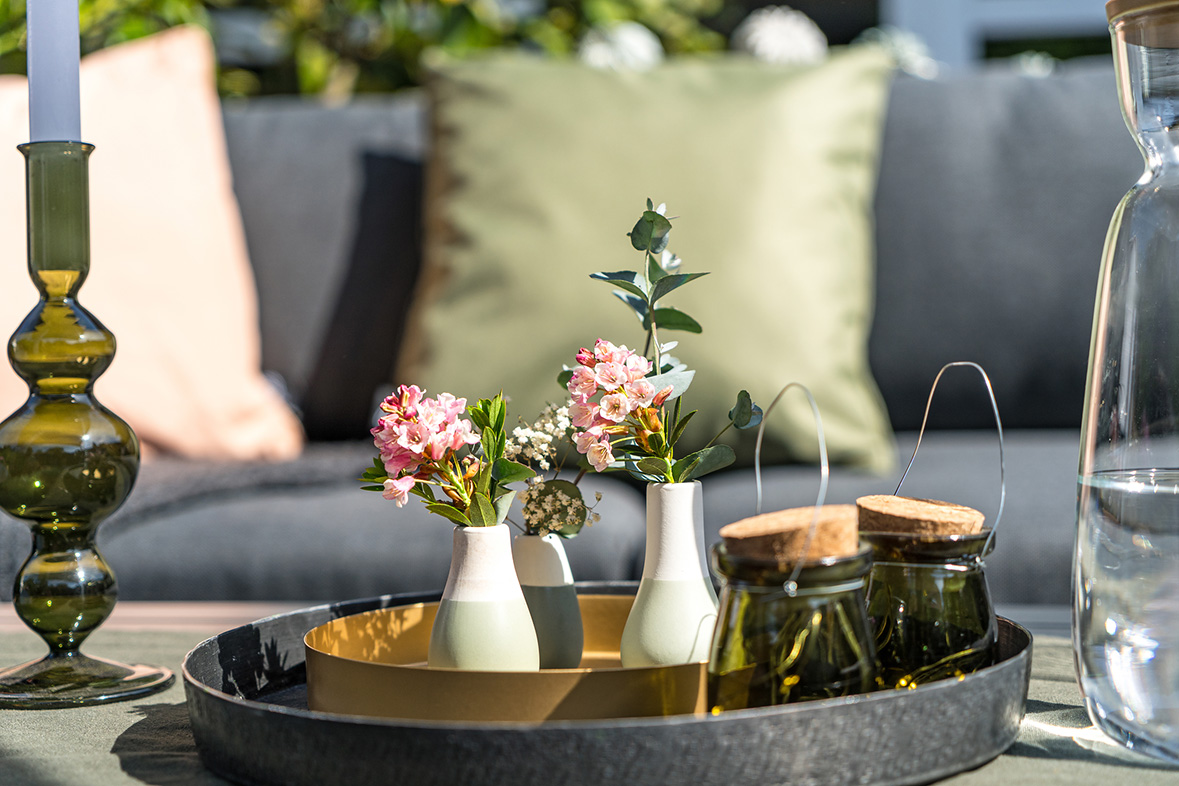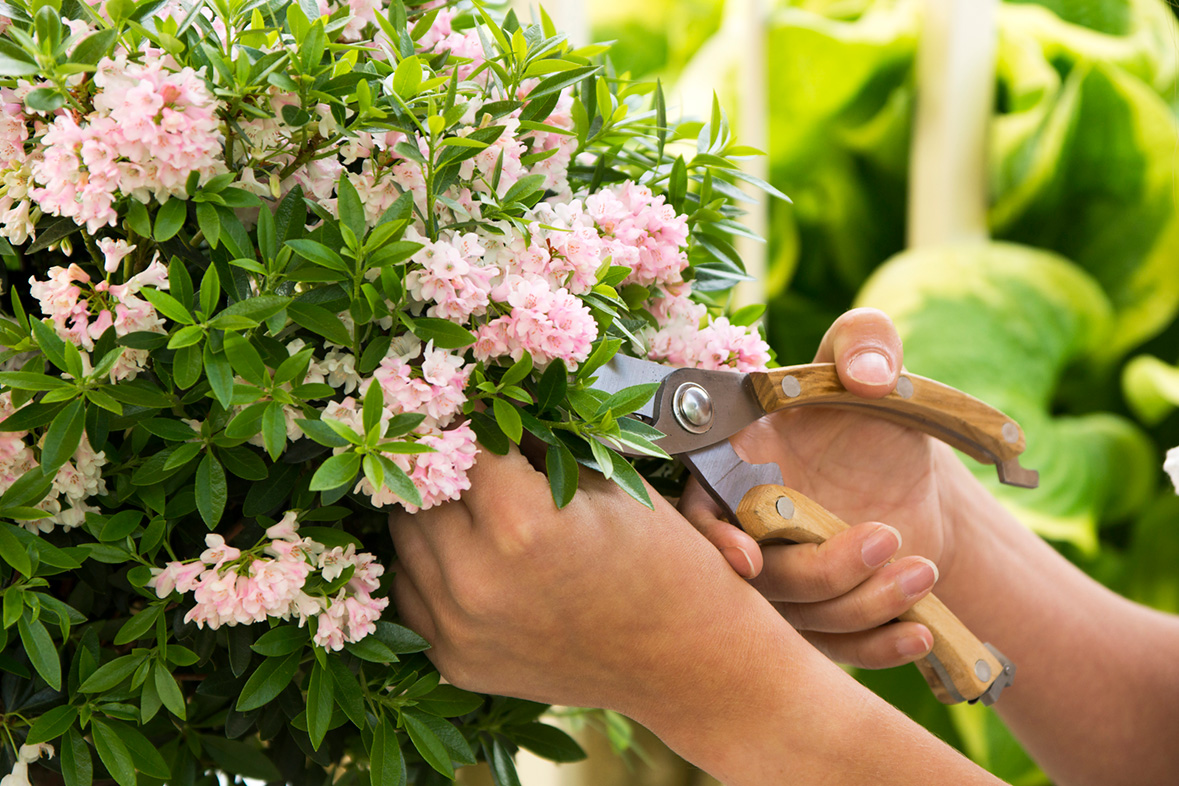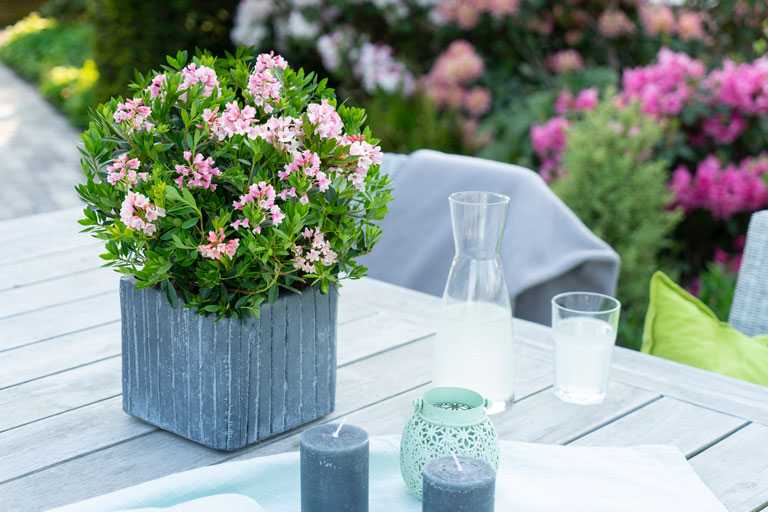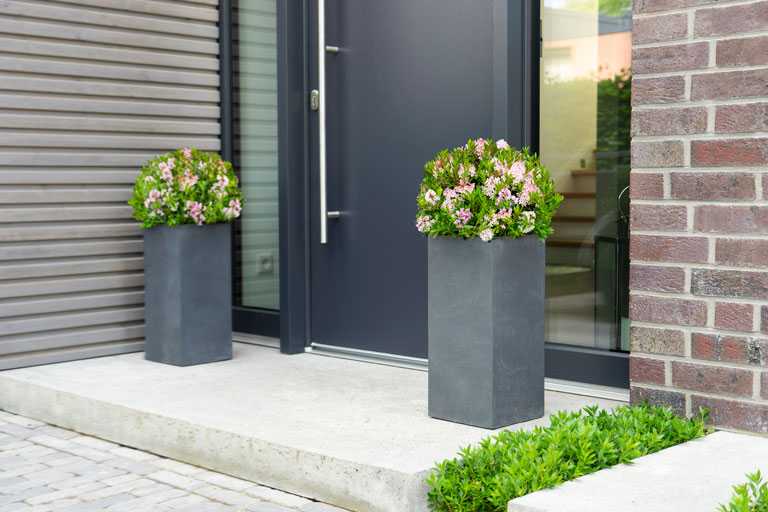


Bloombux® als robuste und blühende Alternative
Among gardeners and landscapers, the box tree is one of the most popular green plants in Germany and Europe. No wonder, since the box tree is unsurpassed when it comes to creating a focal point as a solitary or hedge plant. Furthermore, its individual topiary cut transforms each box tree into a real masterpiece of garden art and thus presents itself as an attractive eye-catcher in any green landscape.
Besides numerous positive attributes, which are often associated with the box tree, there are also a number of disadvantages: The box tree is susceptible to diseases and pests, requires very differentiated and time-consuming care and does not bear any enchanting flowers.
Therefore, our Bloombux® can stand as an alternative to the conventional boxwood.
Find out below, why this is the case and what advantages you can expect.
Planting Bloombux® in a planter


Get to know the boxwood
What is a boxwood?
Even those who would not necessarily include gardening and plants among their hobbies, have usually heard of a box tree. After all, everyone knows the pictures of English gardens, in which huge boxwood balls or other boxwood shapes with their exact cuts are real eye-catchers. The boxwood belongs to the boxwood family (Buxus) and is locally often used as a shrub or hedge plant. The most striking feature is its excellent pruning tolerance - a shape cut can transform the boxwood into any figure of your choice.
While the boxwood belongs to the Buxus category, our Bloombux® comes from a completely different family. This plant does not stem from the boxwood family, but is a rhododendron. This special breed has all the characteristics of a normal boxwood, but boasts some additional features that represent a clear advantage over the genuine boxwood. The Bloombux® is an evergreen that can be used as a hedge plant or as a solitary plant in a pot or in the garden.
Creating a cottage garden with Bloombux®
Bloombux® on the terrace with the 360° panoramic view.
Bloombux®: What are the advantages?
- less susceptible to boxwood pests and boxwood diseases
- magnificent flowers in spring
- faster growth
- tolerant to pruning
- easy-care
The most annoying things for boxwood fans are in particular boxwood pests and boxwood diseases. Boxwood caterpillars and moths can quickly spread in the garden, which then attack and damage all plants. Even fungi or other diseases can easily spread if boxwood are inadequately or incorrectly cared for. You can rely on the Bloombux® in this regard: As a rhododendron, it is insensitive to typical box tree diseases and pests.

Boxwood pests are not an issue with Bloombux®
What to do against the box tree moth?
Especially in recent years, the boxwood moth has been the most common boxwood pest. This is a moth whose offspring are caterpillars that make no halt, not even in huge boxwood stocks. So far, no effective remedy has been developed against the boxwood moth and not only private owners of hedge plants, but also tree nurseries, large-scale nurseries and landscape parks are powerless. The boxwood moth can only be combated with time and patience, because boxwood caterpillars must often be picked off the tree and disposed of manually. On the other hand, the method is not one hundred percent effective, as a new infestation with the boxwood moths can occur at any time.
You will have much less trouble with box tree moths if you opt for a Bloombux® directly instead of a boxwood. After all, our Bloombux®, which has already received several awards as a new plant cultivar, is not a boxwood but a rhododendron. Therefore, the boxwood moth or other boxwood pests cannot harm it. The same is also true for boxwood diseases that can cause shoots to die, leaves to rot and other unsightly symptoms. If you opt for the Bloombux® right from the start, the typical boxwood diseases and pests will not annoy you.

Caring and nurturing the box tree
What does a boxwood need?
The boxwood is an easy-care hedge plant, which has been increasingly infested by boxwood diseases and boxwood pests in recent years. In contrast, the Bloombux® as an alternative to the boxwood is insensitive to these diseases and pests. It is also flexible in terms of soil conditions and is tolerant to lime-scale as well as loose and fresh soils. It prefers semi-shady locations, but can also cope well in sunny spots. The special feature of the Bloombux® is the flowering season between May and June. In this time, the Bloombux® bears magnificent flowers in brightly shining colours that attract bees and butterflies. If desired, the Bloombux® can also be pruned and transformed into a boxwood ball or a small border-hedge. The Bloombux® should be pruned shortly after the flowering season, so that the flower buds of the following year are not damaged.
Planting Bloombux® in a raised bed
Buy a Bloombux® Pink & Magenta
The boxwood is a real classic in European gardens, but has recently made life difficult for hobby gardeners and nursery owners due to boxwood pests and box tree diseases. So why not opt for the Bloombux® right from the start - modern plant cultivation manifests the positive features of the boxwood with its robust nature and the exciting flowers of the rhododendron in one plant.
We would be pleased to inform you about further details of the Bloombux® and its advantages as an alternative to the boxwood.
Protected Variety:
Bloombux Pink (‘MICROHIRS 3’). Propagation and commercial propagation are prohibited!
Bloombux Magenta (‘MICROHIRS 9’). Propagation and commercial propagation are prohibited!
Bloombux® Awards

Gardens of the Year 2020
Winner of “Best product”

Taspo-Award 2015 winner
Cultivar of the year

Bloombux® & Bloombux® Magenta

showyourcolours 2015
Cultivar of the year

German Innovation Prize for
Horticulture 2015
Winner in the “Plant” category

IPM Winner of the
New Products Showcase 2015


















































